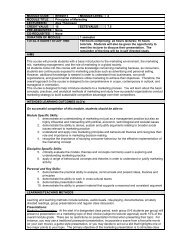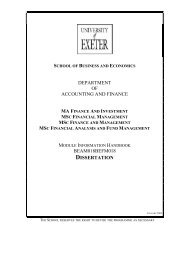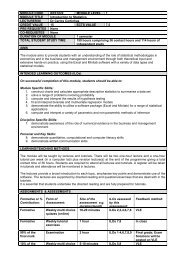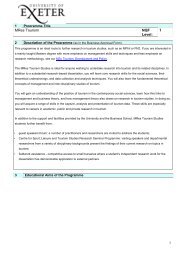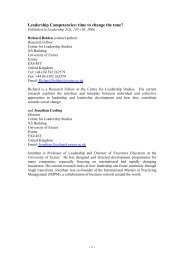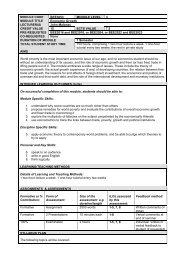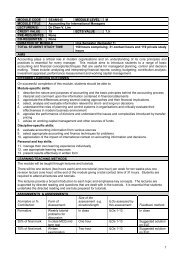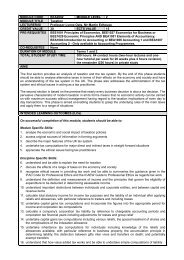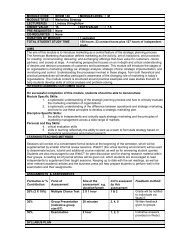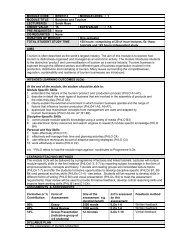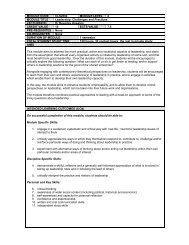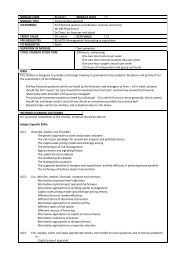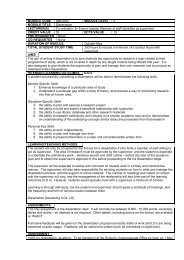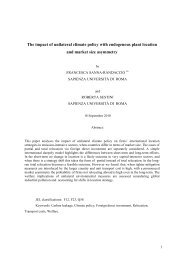What is Leadership? - The Business School - University of Exeter
What is Leadership? - The Business School - University of Exeter
What is Leadership? - The Business School - University of Exeter
You also want an ePaper? Increase the reach of your titles
YUMPU automatically turns print PDFs into web optimized ePapers that Google loves.
the demoral<strong>is</strong>ing effects <strong>of</strong> organ<strong>is</strong>ational<br />
restructuring, competition and<br />
redundancies dominant at the time. <strong>The</strong><br />
char<strong>is</strong>matic leader was seen as someone<br />
who could rebuild morale and <strong>of</strong>fer a<br />
positive v<strong>is</strong>ion for the future.<br />
Th<strong>is</strong> approach, in effect, combines both<br />
notions <strong>of</strong> the transformational leader as<br />
well as earlier trait and ‘great man’<br />
theories. Researchers have taken<br />
different positions, but overall four major<br />
character<strong>is</strong>tics <strong>of</strong> char<strong>is</strong>matic leaders can<br />
be identified: (1) a dominant personality,<br />
desire to influence others and self<br />
confidence; (2) strong role model<br />
behaviour and competence; (3)<br />
articulation <strong>of</strong> ideological goals with<br />
moral overtones; and (4) high<br />
expectation <strong>of</strong> followers and confidence<br />
that they will meet these expectations<br />
(Northouse, 2004, p171).<br />
Despite the hype, confidence in th<strong>is</strong><br />
approach to leadership <strong>is</strong> rapidly<br />
declining. A number <strong>of</strong> high pr<strong>of</strong>ile<br />
corporate scandals, plus the tendency <strong>of</strong><br />
char<strong>is</strong>matic leaders to desert<br />
organ<strong>is</strong>ations after making their changes<br />
(<strong>of</strong>ten leaving even more significant<br />
challenges), has highlighted that th<strong>is</strong><br />
may not be a sustainable way to lead.<br />
Because <strong>of</strong> the way in which char<strong>is</strong>matic<br />
leadership presents the leader as a<br />
saviour, it <strong>is</strong> now <strong>of</strong>ten referred to as<br />
‘heroic leadership’ 1 . <strong>The</strong>re <strong>is</strong> a<br />
res<strong>is</strong>tance to th<strong>is</strong> view <strong>of</strong> the leader<br />
within many industries and organ<strong>is</strong>ations<br />
are seeking alternatives that develop<br />
quieter, less individual<strong>is</strong>tic leadership<br />
(Mintzberg, 1999; Badaracco, 2002).<br />
Servant and team leadership<br />
<strong>The</strong> notion <strong>of</strong> the ‘servant leader’ has<br />
been around for some time. Like Burn’s<br />
early conceptions about transforming<br />
leadership, the emphas<strong>is</strong> <strong>is</strong> on the moral<br />
and ethical dimensions <strong>of</strong> leadership.<br />
<strong>The</strong> difference, however, <strong>is</strong> that the<br />
servant leader follows h<strong>is</strong>/her path out <strong>of</strong><br />
a desire to serve rather an out <strong>of</strong> a<br />
desire to lead.<br />
“<strong>The</strong> servant-leader <strong>is</strong> servant first…<br />
It begins with the natural feeling that<br />
1 See Mintzberg, 2004, p104 for a good<br />
critique <strong>of</strong> th<strong>is</strong> approach.<br />
one wants to serve, to serve first.<br />
<strong>The</strong>n conscious choice brings one to<br />
aspire to lead. He or she <strong>is</strong> sharply<br />
different from the person who <strong>is</strong><br />
leader first, perhaps because <strong>of</strong> the<br />
need to assuage an unusual power<br />
drive or to acquire material<br />
possessions.” (Greenleaf, 1970)<br />
<strong>The</strong> focus on serving a greater purpose<br />
has made th<strong>is</strong> approach popular within<br />
the church and non-pr<strong>of</strong>it sector but has<br />
had limited impact in more commercial<br />
sectors. A related concept that has had<br />
wider acceptance <strong>is</strong> that <strong>of</strong> ‘team<br />
leadership’.<br />
Katzenbach and Smith (1993) emphas<strong>is</strong>e<br />
the importance <strong>of</strong> leaders knowing when<br />
to follow and the importance <strong>of</strong> the<br />
leader acting as a facilitator rather than<br />
director. <strong>The</strong>y propose that the leader<br />
should ask questions rather than giving<br />
answers; provide opportunities for others<br />
to lead them; do real work in support <strong>of</strong><br />
others instead <strong>of</strong> only the reverse;<br />
become a matchmaker instead <strong>of</strong> a<br />
‘central switch’; and seek a common<br />
understanding instead <strong>of</strong> consensus.<br />
Belbin (1993) presents a similar image<br />
<strong>of</strong> the team leader as someone who<br />
chooses to delegate and share team<br />
roles; builds on and appreciates<br />
diversity; seeks talented people;<br />
develops colleagues; and creates a sense<br />
<strong>of</strong> m<strong>is</strong>sion.<br />
D<strong>is</strong>tributed leadership<br />
An increasing awareness <strong>of</strong> the<br />
importance <strong>of</strong> social relations in the<br />
leadership contract, the need for a<br />
leader to be given authority by their<br />
followers and a real<strong>is</strong>ation that no one<br />
individual <strong>is</strong> the ideal leader in all<br />
circumstances have given r<strong>is</strong>e to a new<br />
school <strong>of</strong> leadership thought. Referred<br />
to as ‘informal’, ‘emergent’, ‘d<strong>is</strong>persed’<br />
or ‘d<strong>is</strong>tributed’ leadership, th<strong>is</strong> approach<br />
argues a less formal<strong>is</strong>ed model <strong>of</strong><br />
leadership (where leadership<br />
responsibility <strong>is</strong> d<strong>is</strong>sociated from the<br />
organ<strong>is</strong>ational hierarchy). It <strong>is</strong> proposed<br />
that individuals at all levels in the<br />
organ<strong>is</strong>ation and in all roles (not simply<br />
those with an overt management<br />
dimension) can exert leadership<br />
influence over their colleagues and thus<br />
12 www.leadershipsouthwest.com



